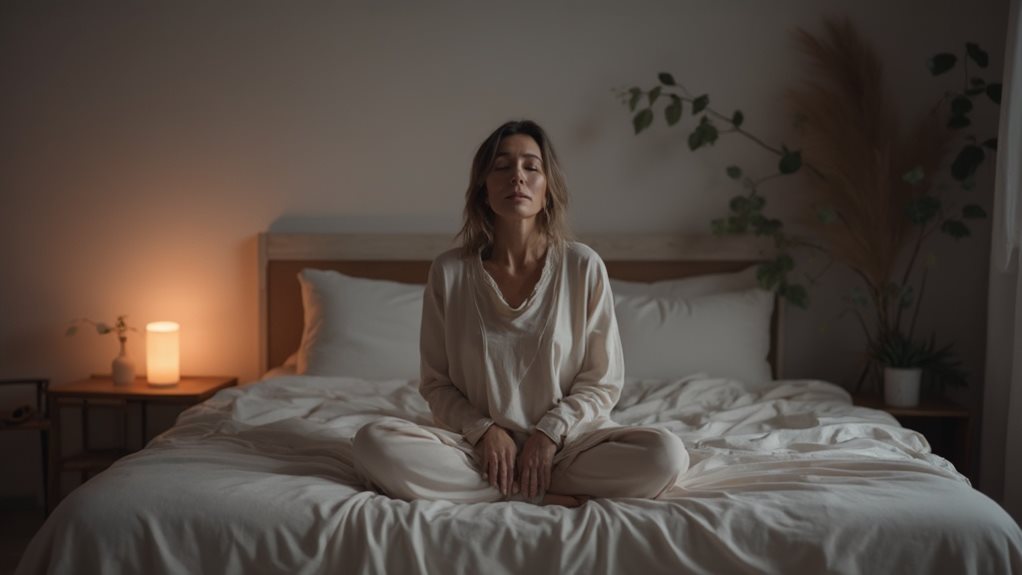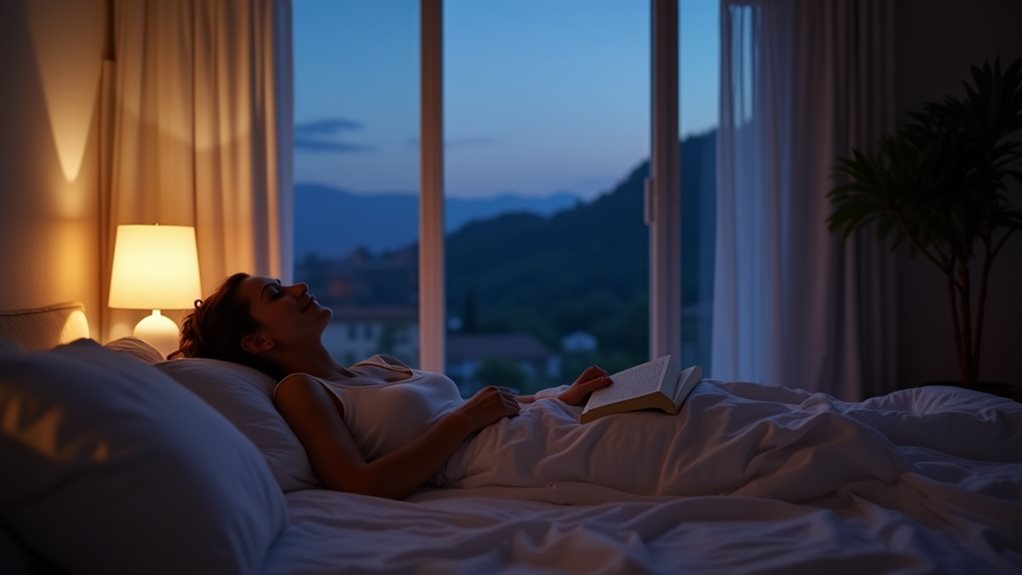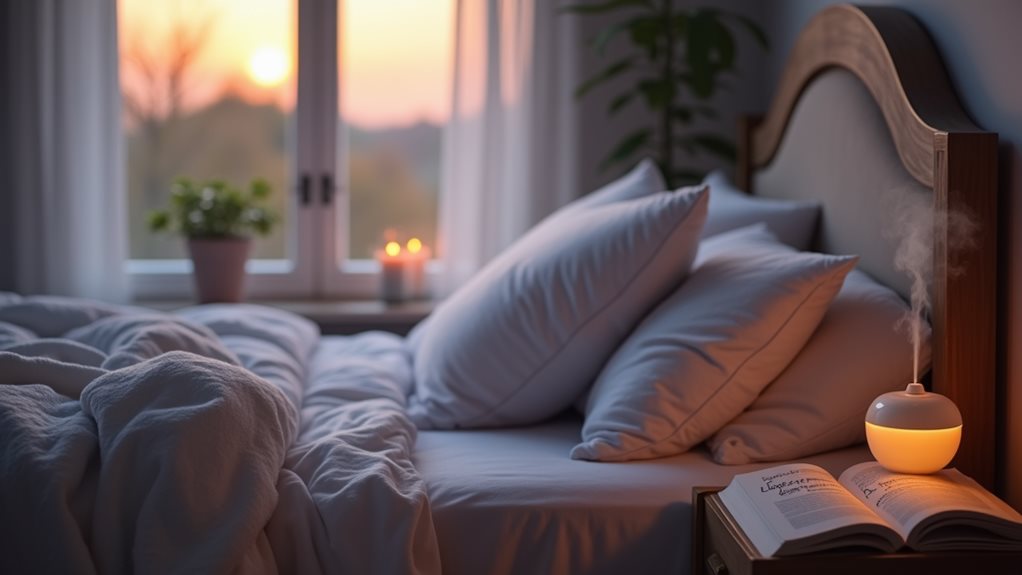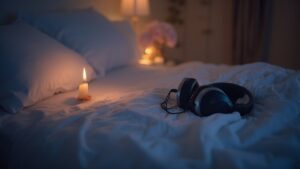
Self-hypnosis is a valuable tool for those seeking to improve their sleep quality. By employing techniques like guided relaxation, visualizations, and positive affirmations, individuals can ease into a deeper, more tranquil sleep. Creating a conducive environment with dim lighting, soothing soundscapes, and incorporating calming aromas like lavender further enhances the effectiveness of self-hypnosis. Mastering breathing techniques also plays an essential role in promoting relaxation. Exploring these strategies further can greatly enrich one's nightly routine for better rest.
Key Takeaways
- Practice guided relaxation to calm your mind and ease into sleep through self-hypnosis techniques.
- Integrate visualization by imagining tranquil scenes like serene beaches to deepen relaxation.
- Employ the 4-7-8 breathing method to slow your heart rate and promote a state of calm.
- Use aromatherapy with essential oils such as lavender to create a soothing sleep environment.
- Establish a nightly routine that includes these self-hypnosis practices to improve sleep quality consistently.
The Basics of Self-Hypnosis for Improved Sleep
Self-hypnosis emerges as a powerful tool for enhancing sleep quality, offering a gentle yet effective approach to overcoming the challenges of insomnia and irregular sleep patterns.
By incorporating simple self-hypnosis techniques into their nightly routine, individuals can greatly improve their sleep quality. These methods involve guided relaxation, affirmations, and visualizations that promote calmness and readiness for sleep.
Regular practice not only helps in falling asleep quicker but also in achieving deeper, more restorative sleep. This reassuring process empowers individuals to manage their sleep health proactively, creating a positive impact on overall well-being and daily functioning.
Creating the Perfect Environment for Relaxation
As individuals embrace the practices of self-hypnosis to enhance sleep quality, it becomes equally important to focus on the physical spaces where relaxation occurs.
Crafting the perfect environment involves careful consideration of lighting ambiance and soundscapes selection. Dim, warm lighting can soothe the senses, ushering in a state of calm.
Simultaneously, selecting appropriate soundscapes that resonate with tranquility, such as soft ocean waves or gentle rain, can greatly deepen relaxation.
These elements work synergistically to create a sanctuary that not only promotes relaxation but also reinforces the effectiveness of self-hypnosis routines, leading to more restful nights.
Mastering Breathing Techniques to Enhance Hypnosis

To effectively deepen the state of self-hypnosis, mastering various breathing techniques is essential. Breathing patterns play a critical role in triggering the body's relaxation response, essential for a successful hypnosis session.
Techniques such as diaphragmatic breathing encourage a full oxygen exchange and reduce the heart rate, promoting calmness. Practicing the 4-7-8 breathing technique can particularly enhance this effect, where one inhales for four seconds, holds the breath for seven, and exhales for eight.
These methods not only improve the depth of hypnosis but also assist in maintaining a steady, rhythmic pattern that fosters profound relaxation and mental ease.
The Power of Visualization in Achieving Serenity
Harnessing the power of visualization can greatly transform one's approach to relaxation and serenity, particularly in the context of self-hypnosis.
By employing imagery techniques, individuals can mentally transport themselves to peaceful landscapes, such as tranquil beaches or serene forests. This mental shift not only soothes the mind but also fosters a deep state of calm.
The vividness of such scenes enhances the relaxation experience, making the change into sleep smoother and more natural. Regular practice of these visualization strategies can considerably improve sleep quality, encouraging a nightly journey into restfulness that rejuvenates both mind and body.
Integrating Aromatherapy Into Your Nightly Routine

Integrating aromatherapy into your nightly routine can greatly enhance the quality of your sleep. Utilizing essential oils with known calming scents, such as lavender and chamomile, can markedly amplify the essential oil benefits, promoting a tranquil environment conducive to rest.
These aromatic compounds interact with the limbic system in the brain, easing anxiety and facilitating deeper relaxation. By adding a few drops of these oils to a diffuser or applying them topically with a carrier oil, one can create a soothing atmosphere that not only comforts but also prepares the mind and body for a restorative night's sleep.
Frequently Asked Questions
Can Self-Hypnosis Help With Insomnia Caused by Anxiety?
Self-hypnosis can be effective for managing anxiety and improving sleep. Techniques like deep breathing, visualization, and calming routines address insomnia by promoting relaxation and reducing stress, enhancing overall sleep quality and well-being.
How Long Should Each Self-Hypnosis Session Be for Optimal Results?
In the domain of mental repose, each self-hypnosis session duration should ideally last 20 to 30 minutes. Preferred frequency is daily practice, fostering a sanctuary of calm that progressively enhances sleep quality and relaxation.
Is Self-Hypnosis Safe for Pregnant Women?
Self-hypnosis is generally considered safe for pregnant women, offering benefits like enhanced relaxation and stress reduction. However, it's advisable to consult a healthcare provider before starting any new relaxation techniques during pregnancy.
Can Self-Hypnosis Prevent Sleepwalking Episodes?
While not a guaranteed solution, self-hypnosis might minimize sleepwalking episodes by addressing underlying triggers like stress. Its effectiveness varies, promoting relaxation which can potentially stabilize sleep patterns and reduce nocturnal disruptions.
Are There Age Restrictions for Practicing Self-Hypnosis for Sleep?
There are no specific age restrictions for practicing self-hypnosis for sleep. However, age suitability varies, and children's hypnosis should be guided by professionals to guarantee it is conducted safely and effectively.
Conclusion
Incorporating self-hypnosis into nightly routines has been shown to make a significant difference. A study highlights that individuals practicing self-hypnosis experienced a 30% improvement in sleep quality. This statistic underscores the effectiveness of these techniques in not only facilitating faster sleep onset but also in enhancing the overall sleep experience. Embracing self-hypnosis can be a gentle and effective strategy towards achieving a more restful and rejuvenating night, ultimately supporting greater health and well-being.





